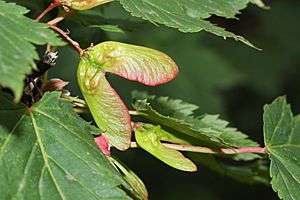Acer traini facts for kids
Quick facts for kids Acer traini |
|
|---|---|
| Scientific classification | |
| Genus: |
Acer
|
| Species: |
traini
|
Acer traini was an ancient type of maple tree. It's now extinct, meaning it no longer exists on Earth. Scientists know about it from its fossilized seeds, which are called samaras. These fossils have been found in Canada and the United States. Acer traini belongs to the same group as some living maple trees today, like the Douglas maple.
Discovering an Ancient Maple
Scientists learn about Acer traini from its fossils. These fossils are like clues from the past. They were found in different places across western North America.
- The northernmost fossils were found in central British Columbia, Canada. This area is known for its Early Miocene period fossils.
- In the United States, fossils were found in two places in Oregon: the White Hills site and the Trout Creek area.
- Another fossil was found in southern central Idaho, at a place called the Trapper Creek flora.
- Two more sites in Nevada also had A. traini fossils. These were the Thurston Ranch flora and the Purple Mountain flora.
Most of these places only had one fossil each. The Trout Creek area was special because it had two. In total, only seven fossil specimens of Acer traini have been found!
The main fossil specimen is kept at the University of Michigan Museum of Paleontology. Another important specimen is at the University of California Museum of Paleontology.
Who Studied These Fossils?
Two important scientists studied these ancient maple seeds. They were Jack A. Wolfe from the United States Geological Survey and Toshimasa Tanai from Hokkaido University in Japan.
In 1987, Wolfe and Tanai wrote a scientific paper about Acer traini. They published their findings in a journal from Hokkaido University. They named the species traini to honor Percy Train. He was a fossil collector who found many fossils in the Trout Creek area.
What Did It Look Like?
The fossil seeds of Acer traini give us clues about the plant.
- The main part of the seed, called the "nutlet," was shaped like a triangle. It was about 0.5 to 0.9 centimeters (0.2 to 0.35 inches) long. It was also about 0.4 to 0.8 centimeters (0.16 to 0.31 inches) wide.
- The nutlet had three clear ridges, or raised lines. One ridge was very noticeable, running down the middle.
- The seed also had a "wing," which helped it spin and fly in the wind. The wing was about 1.2 to 2.5 centimeters (0.47 to 0.98 inches) long. It was about 0.6 to 1.2 centimeters (0.24 to 0.47 inches) wide.
- Maple seeds usually come in pairs. For A. traini, these paired seeds were attached at an angle of 30 to 40 degrees.
- The wing had six clear veins, which are like tiny tubes that carry nutrients. These veins started at the tip of the nutlet and curved along the edge of the wing.

Scientists Wolfe and Tanai noticed something interesting. The fossil seeds of Acer traini looked very similar to the seeds of a living maple tree called the Douglas maple (Acer glabrum).
They thought that if scientists ever find fossil leaves of Acer traini that also match the Douglas maple, then Acer traini might actually be the same species as Acer glabrum. In science, when two different names are given to the same species, the older name is usually kept, and the newer one becomes a "synonym." But for now, since only the seeds have been found, Acer traini is still considered a separate species.

